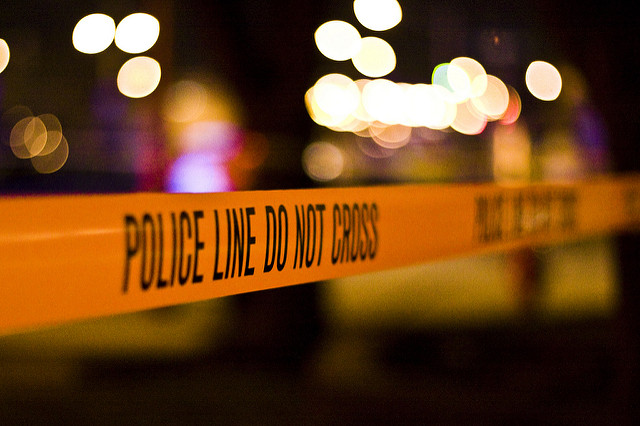Yellow tape is the boundary between one world and another. Law and crime. Public and private. Allowed and not allowed. Even, to some extent, the past and the present. Crime scenes are sealed off by yellow tape to preserve them as they were. This gives us the sense that something that happened in the past can be forcibly held there. Police tape is a means of keeping people safe from undefined harm. It is a means of protecting evidence. It is an assertion of power by the state. It is flimsy. It is absolute.
Crime-scene tape is deeply alive in the popular imagination. Chris Brown has a song called “Yellow Tape,” and at a concert in Tampa last year, a day after he was arrested for punching a photographer, he strung up police tape and played videos of flashing sirens. Yellow tape appears in the opening credits of CSI: Las Vegas and in stock photos that newspapers use to signal to readers: this is a story about crime. ABC News once even got in trouble for faking a crime scene by putting yellow tape up between two poles, which read, “Sheriff’s line do not cross.” The broadcaster stood in front of it, trafficking in the cultural weight of the yellow tape and what viewers naturally understand from it, even if it’s fake.
Yellow crime-scene tape has been around since the early ’60s, according to a 1998 Miami Herald article, one of the few reputable sources on the subject. Its technical name is “barricade tape,” and it’s made with a durable lightweight plastic material called polyethylene that’s difficult to rip. It’s yellow because yellow is the color of warnings.
Barricade tape draws its power, I think, from being simultaneously provocative and ubiquitous. Law enforcement uses miles of it every day, though it’s hard to say exactly how many. “That information is not tracked,” Lt. John Grimpel of the NYPD told me, when I asked about how much tape the department uses. In 1998, though, according to the Herald article, the Miami-Dade Police Department had stockpiled about 37 miles of tape for the year. In Miami itself, police had more than 75 miles on hand, with more on order.
Police tape is imbued with an explicit and understood meaning: keep out. That applies to the average passerby. It applies to friends and family of a crime victim. It applies to anyone who might want to tamper with evidence. It applies to someone who might be trying to go to the park. It applies to people who are writing about crime.
Reporters can’t cross police tape, even with a press pass. This is actually a somewhat gray area of the law, but in practice, the law tends to side with the law. This is even the case in the absence of yellow tape. In 2004, Robert Boyer, a reporter for the Fayetteville Observer in North Carolina, showed up at 1:30 in the morning to an address where police were investigating a death. There was no yellow tape, but police told him to get lost. He refused, six times. In court, the prosecution argued that officer who blocked his access was acting as “walking crime scene tape.” The judge agreed.
Crime-scene tape, then, doesn’t even have to exist to be powerful. It is the physical manifestation of the enforcement arm of the state’s power to draw boundaries, which exists either way.
How does actual, physical tape function in our understanding of crime itself? Maybe yellow tape is useful in thinking about a broad understanding of a crime as confinable to a single space, as an act between a number of individuals, as a certain thing that’s occurred at a moment in time and has a story with a finite beginning and ending.
There is increasingly a division between people who think a crime should be viewed as a single act and people who think a crime should be seen as something within a broader context of social and economic forces, some of which might be worse than the crime itself. Isn’t there a way in which the constant violence of capitalism is worse than a stabbing? Maybe. Taken to the extreme, this would collapse almost everything we think we know about crime—who would be the victim and who would be the suspect? How would we have laws? Practically, legally, as a nation, we are far from such a place. Clearly, though, there are ways our current justice system could be reformed to better incorporate the violence that we might term “systemic” into the calculus about crime.
Dispelling the mythology of yellow tape would be useful, I think, in expanding our understanding of crime. Yellow tape is both a metaphor for and an actualization of how we view crime and punishment. It is a definite parameter imposed on something infinitely more complicated, whose roots and consequences are deep, fluid, and often unknown.
The tape says do not cross do not cross do not cross, but we should also remember how porous this boundary is, how artificial, how powerful.






